Do you want to grow a healthy organic fruit orchard but don’t know where to begin? Learn how to grow lots of tasty fruit trees in a green way. You’ll find out how to make your trees strong and free from pests easily. We’ll show you how to plant, control pests, and care for your trees for many harvests.
Organic fruit growers know that perfect fruit isn’t everything. A few marks don’t change the taste or nutrition. By focusing on soil health, pruning, and fighting pests naturally, you can get a great harvest and help the planet. Here are some tips to make your organic fruit trees do well.
Choose the Right Planting Site
Choosing the right spot for organic fruit trees is key for their health and growth. You need to think about a few important things to make sure they do well.
Factors to Consider for an Ideal Planting Site
Soil type is very important for fruit trees. You want a spot with good drainage to stop diseases. The amount of organic matter in the soil affects how well it drains and holds water. The best soil pH for most trees is between 6.0 and 7.0.
Think about disease resistance when picking a spot. Stay away from Juniperus species (Eastern red-cedar) to avoid cedar-apple rust. Picking disease-resistant fruit tree varieties helps keep your orchard healthy longer.
Also, make sure your spot gets a lot of sunlight. Fruit trees and shrubs need lots of light, especially in cooler places. This helps them set and ripen fruit properly.
| Consideration | Recommendation |
|---|---|
| Soil Composition | Well-drained, with 6.0-7.0 pH and high organic matter content |
| Disease Resistance | Avoid planting near Juniperus species (Eastern red-cedar), select disease-resistant varieties |
| Sunlight | Fruit trees and shrubs require maximum sunlight exposure for optimal fruit production |
By thinking about these site selection factors, you can give your organic fruit trees the best chance to grow and produce well.
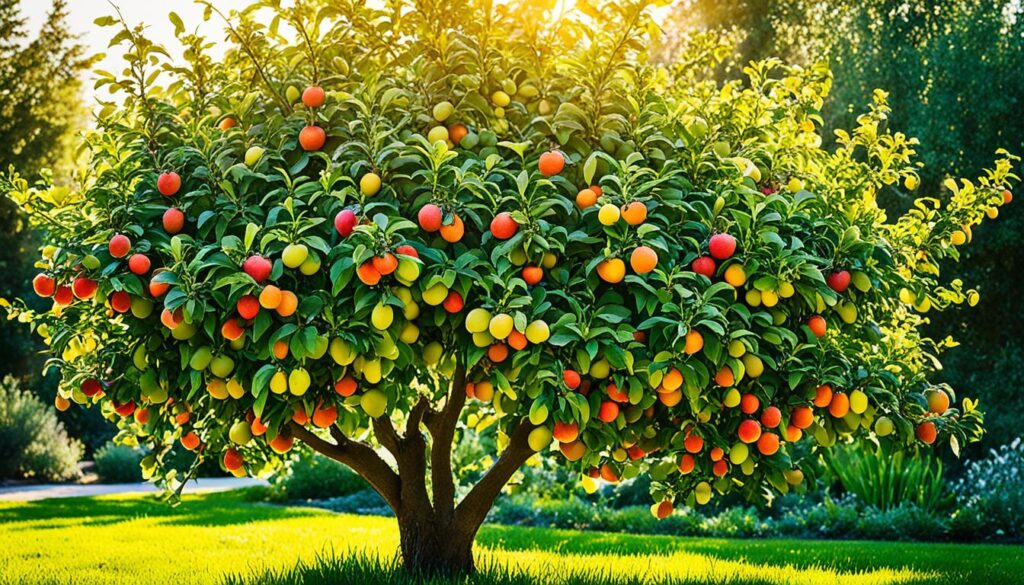
Implement Organic Pest and Disease Control
Caring for your organic fruit trees means keeping pests and diseases away. Luckily, you have many natural and safe options. These can help you grow healthy trees.
Organic Fungicides and Insecticides
Use Actinovate and Monterey Complete Disease Control to fight fungal diseases. These can stop root rot and verticillium wilt. For bugs, try insecticidal soap and neem oil. They work well against aphids and other pests. Kaolin clay can also keep insects and some diseases away.
Apply these organic products at the right time. This means when pests and diseases are most active. Doing this helps keep your trees healthy and pest-free.
- Organic fungicides: Actinovate, Monterey Complete Disease Control
- Organic insecticides: Insecticidal soap, neem oil
- Physical barrier: Kaolin clay
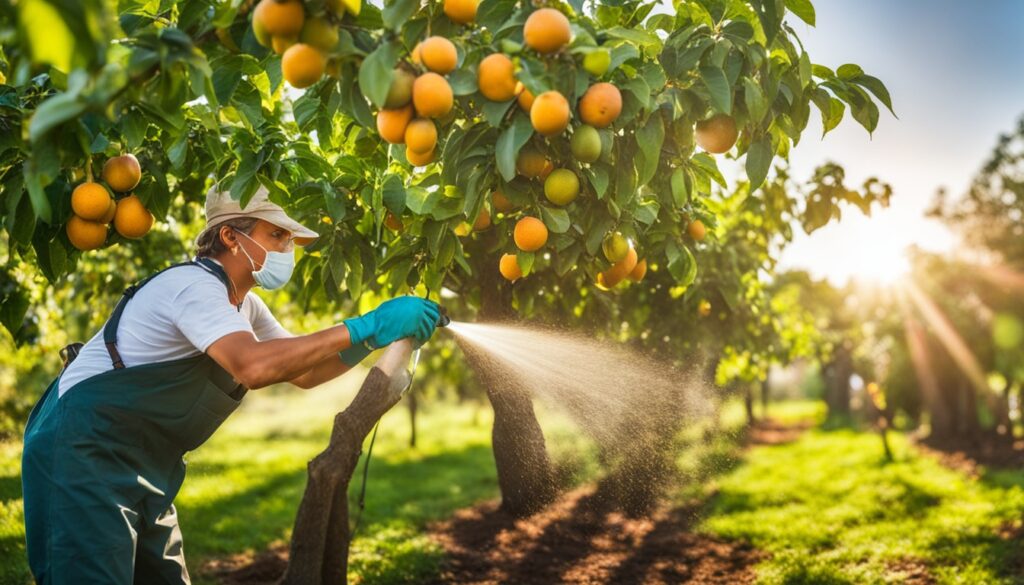
Using these natural products helps you fight pests and diseases. It also keeps your organic fruit trees strong and healthy.
Prune and Clean Up Regularly
Keeping your organic fruit trees healthy and productive means you need to prune them often. Proper pruning helps get rid of dead, sick, or broken branches and leaves. This stops pests and diseases from spreading. Make sure to throw away the cut parts far from the trees to keep them clean.
Don’t compost parts that might be sick to stop diseases from coming back. Pruning should be done when trees are dormant, usually from December to February. There are two main pruning cuts: thinning and heading cuts.
These cuts help make the tree strong, control how much fruit it grows, and make sure it gets enough sunlight. Different trees need different pruning systems, like open center or vase-shaped, central leader, or «Y» system.
Using sharp tools is key for clean cuts and safety when removing debris. Pruning techniques greatly affect your trees’ health and how much they produce.
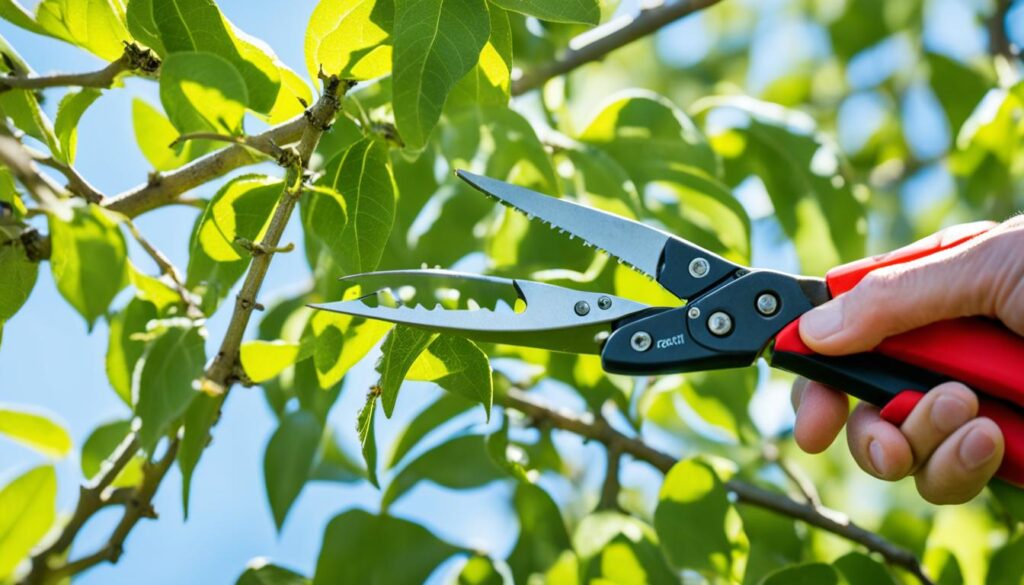
Pruning old or forgotten trees might take a few years to fix them up. It’s important to have a clear plan for pruning these trees. This way, you can make them safe and easy to manage. Regular pruning and debris removal help your organic fruit trees stay healthy and live longer.
Test and Amend Soil
Healthy soil is key for growing organic fruit trees. Before planting, test your soil to know its composition, pH, and nutrient levels. Most fruit trees like soil with a pH between 6.0 and 7.0. If your soil is too acidic or alkaline, fix it with amendments.
Adding more organic matter to the soil helps with drainage and holding water. This is crucial for healthy fruit trees. Based on your soil test, you might need to add soil amendments like compost, lime, or other materials to make the soil better.
- Do a full soil test to check the soil’s make-up, pH, and nutrient levels.
- Change the soil pH to 6.0-7.0 with things like ground limestone or wood ashes if needed.
- Add organic stuff, like well-composted manure or compost, to better the soil structure and nutrient levels.
- Fix any nutrient deficiencies found in the soil test with the right soil amendments.
| Soil Test Level | Recommended Pre-Plant Phosphorus (P) Application |
|---|---|
| Low | Apply 50-100 lbs/acre of P2O5 |
| Medium | Apply 25-50 lbs/acre of P2O5 |
| High | No additional P needed |
By testing and amending your soil, you’ll give your organic fruit trees the best growing conditions. This ensures they stay healthy and productive for a long time.
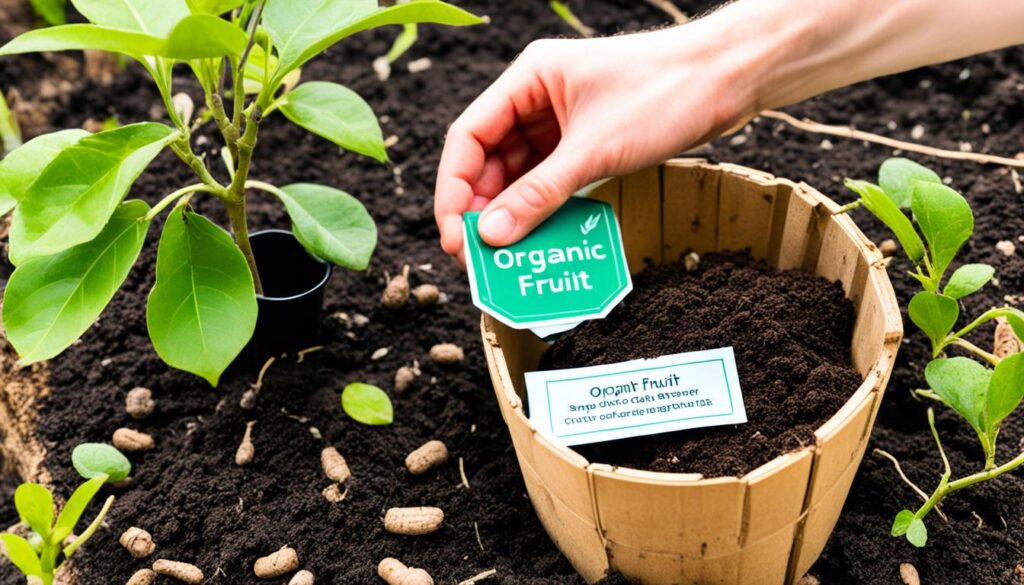
Organic Fruit Tree Care
Caring for organic fruit trees means taking a holistic, integrated approach. It’s not just about certain techniques. It’s also about watching closely and fixing problems fast. This is key for organic fruit tree care.
It’s important to help good bugs, prune trees right, and clean them. Also, following a yearly care plan is key. These steps are part of a organic fruit tree care plan. They help keep your trees healthy and full of fruit for a long time.
- Watch trees often for pests or diseases and fix problems quickly.
- Help good bugs live in your trees to fight pests naturally.
- Keep trees clean and pruned to stay healthy.
- Follow a yearly plan for the best care.
Using a full, holistic approach to organic fruit tree care keeps your trees strong and fruitful. It also cuts down on harmful chemicals. This way, you get a better integrated pest management plan.
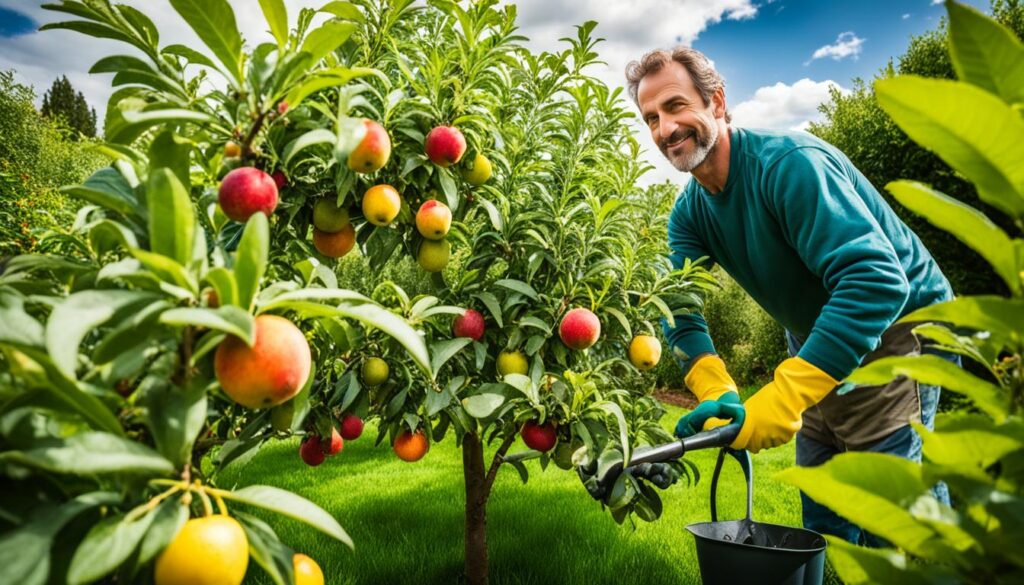
Water and Fertilize Appropriately
Proper irrigation and fertilization are key for organic fruit trees. New trees need regular, deep watering to grow strong roots. They should get 1 to 1.5 inches of water each week.
Older trees need watering that goes deep and is regular. Adjust how often you water based on the soil’s moisture. Adding organic mulch helps keep soil moist and controls weeds.
Choosing the right organic fertilizers is important for trees. Fertilize in early spring before buds open. Stop using nitrogen in July to avoid late growth that won’t harden off before winter.
How much fertilizer trees need varies. Peaches and nectarines grow 18-24 inches a year. Plums and sweet cherries grow 22-36 inches.
Fruit trees do well with high-nitrogen fertilizers like blood meal and soybean meal. Young trees need 0.10 pounds of nitrogen per year or per trunk inch. Don’t put fertilizer too close to the trunk. You can also spread it out by digging holes 6 inches deep and 12 to 18 inches apart.
Keeping the soil health in check is key for trees. The best soil pH for fruit trees is 6 to 6.5. Testing the soil can show if it lacks nutrients. Adjusting the soil’s pH and magnesium can help trees grow and produce fruit well.
Encourage Beneficial Insects
Adding beneficial insects to your fruit tree garden helps control pests naturally. Predatory insects like ladybugs, lacewings, and parasitic ones can eat pests like aphids and mites. By planting flowers and avoiding harsh chemicals, you help these beneficial insects thrive. This means you use fewer chemicals to fight pests.
Here are some important facts about beneficial insects in natural pest control and integrated pest management:
- Ladybugs can eat up to 50 aphids per day.
- Hoverflies larvae can consume up to 60 aphids per day.
- Lacewings larvae eat aphids, caterpillars, mealybugs, leafhoppers, insect eggs, and whiteflies.
- Ground beetles eat insect eggs and larvae.
- Trichogramma wasps lay up to 300 eggs in moth or butterfly eggs.
- Braconid, chalcid, and ichneumon wasps parasitize caterpillars by laying eggs in or on them.
To draw and support these beneficial insects, plant many types of flowers. These flowers should have nectar and pollen. Families like Apiaceae, Asteraceae, Fabaceae, Brassicaceae, and Verbenaceae are great choices. Don’t use broad-spectrum pesticides and make sure there’s water and places for them to live. By doing this, you can control pests naturally and use fewer chemicals.
Monitor and Address Issues Promptly
Keeping your organic fruit trees healthy needs you to watch them closely and act fast. It’s key to check for pests and diseases early. This helps stop problems like aphids, codling moths, brown rot, apple scab, and fire blight before they get worse.
Common Pests and Diseases
Knowing what pest or disease is bothering your trees is the first step to fixing it. Pest identification and disease diagnosis help you find the right organic way to control them. After figuring out the problem, you can use preventative measures and organic solutions that fit the issue.
Keeping your orchard clean and doing things like pruning are key to preventing problems. Using the right organic sprays or treatments at the right time can also help. Fixing issues quickly helps protect your trees and ensures a good harvest.
| Pest or Disease | Symptoms | Organic Control Measures |
|---|---|---|
| Aphids | Curled, discolored leaves; sticky honeydew | Insecticidal soap, neem oil, encourage beneficial insects |
| Codling Moth | Larvae burrowing into fruit, causing damage | Pheromone traps, Bacillus thuringiensis (Bt), remove infested fruit |
| Brown Rot | Soft, brown, rotting fruit; fungal growth | Copper-based fungicides, remove and destroy affected fruit |
| Apple Scab | Olive-green to black lesions on leaves and fruit | Sulfur-based fungicides, rake and remove fallen leaves |
| Fire Blight | Wilted, blackened leaves and branches | Prune affected areas, apply copper-based bactericides |
Follow Seasonal Maintenance Cycles
Caring for your organic fruit trees needs a thoughtful plan. In winter, use dormant sprays like neem oil to fight pests and diseases. When buds break and flowers bloom in spring, organic sprays protect the new growth and developing fruit.
At petal fall, young fruit needs protection. Use organic sprays to fight off diseases and pests. Keep an eye on your trees all season and fix any problems fast for a great harvest.
- Dormant season: Apply dormant sprays to control pests and diseases.
- Bud break and flowering: Use organic sprays to protect new growth and fruit.
- Petal fall: Apply organic fungicide and insecticide treatments.
- Throughout the season: Watch the fruit and fix problems quickly.
Stick to this seasonal maintenance plan. Your organic fruit trees will grow well and give you lots of quality fruit every year.
Research and Seek Local Expertise
When taking care of organic fruit trees, it’s key to do your homework and get advice from local pros. Talking to your state’s agricultural extension service or nearby nurseries can give you great tips. They know which fruit tree types work best in your area, how to prepare the soil, and how to handle pests and diseases.
Local experts are a big help when picking the right fruit tree types for your spot. They know which ones fit your local weather, soil, and pests best. This advice helps you choose wisely, making your organic fruit trees healthy and productive.
Experts can also teach you the best ways to plant, prune, and care for your fruit trees. By learning from local growers and plant experts, you can manage pests and diseases well. You’ll know how to feed your trees and solve any growing problems that come up.



